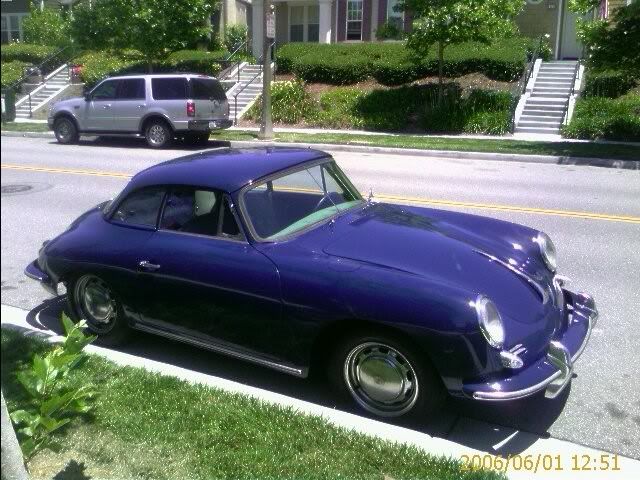

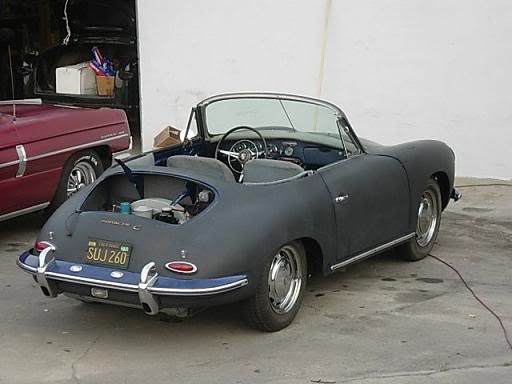
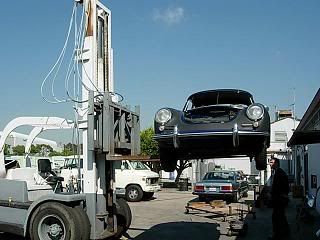

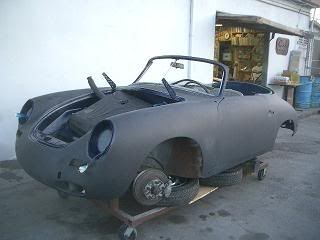
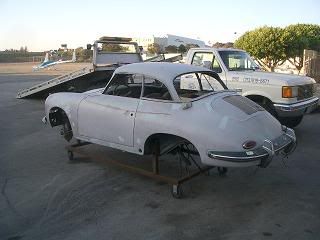
Two years ago I started the process of finishing the restoration of my fathers car. We are almost done. There is a light at the end of the tunnel.
This is a blog dedicated to Catholicism, Traditional Conservatism and Traditional Culture.


From ChristusRex:
In 1009 AD, the Fatimite Khalif of Egypt al-Hakim explicitly ordered the destruction of the Church of the Holy Sepulchre. The Arab historian Yahia ibn Sa`id describe the events thus: "the holy deed commenced on Tuesday, the fifth day before the end of the month of Safar of the year 400 of the Egira (1009 AD in our calendar). Only those parts of difficult access were spared". They started by demolishing the tomb itself, the dome and the high parts of the buildings until the debris at their feet blocked their destruction.
For eleven years the Christians were prohibited to visit the rubbles on the site and were not allowed in to pray in these ruins. It was only some years later that the Christians could rebuild their sanctuary on the site. This was due to a peace treaty between the Byzantine emperor Argyropulos and the successor of al-Hakim in which the reconstruction of the Holy Sepulchre basilica was stipulated. Works started under emperor Constantine Monomacus.
 Columns from the Constantinian Basilica |
When the imperial architects arrived in Jerusalem they concluded that it was impossible to restore the whole Constantinian structure. So they opted to keep only the Anastasis with a large apse towards the East and various small chapels in the area of the Cloister-garden and the Martyrium. These works were carried out between 1042 and 1048. In this reconstruction the eastern Atrium, the Martyrium and the Cloister-garden vanished! And with the restoration of the Anastasis and of the bishop's seat the beauty of the direct lighting from the sun was lost forever!
 Marble flooring done during emperor Monomacus. |
Notwithstanding the changes the new set-up provided also some works of splendor. Mosaics covered the walls and the dome. The Russian abbot Daniel visited Jerusalem in 1106-1107 and left this description: "The Church of the Resurrection is of a circular form having twelve monolithic columns and six pillars. Its floor is made of beautiful marble slabs.
| Marble floor from emperor's Monomacus time |
It has six entrances and tribunes with 12 columns. Lively mosaics of the holy prophets are under the ceiling, over the tribune. The altar is surmounted by a mosaic image of Christ. In the main altar one can see the mosaic of the Exhaltation of Adam. In the apse the Ascension of Christ. The Annunciation occupies the two pillars next to the altar. The dome of the church is not closed by a stone vault but is made up of wooden beams in a truss form. In this way the Church has an opening at the top. The Holy Sepulchre stands under this open dome..."
 The chapel "Prison of Christ" |
The pilgrim Daniel saw mosaics in the Chapel of the Crucifixion on Golgotha. He visited the chapel of the "Prison of Christ", that of the "Finding of the Cross" and the chapel dedicated to Jesus' apparition to his mother to the north of the Anastasis.
----------
At least it didnt get converted to a Mosque like most Christian holy sites that fall under mohammadan rule.
CBN.com – STONETOWN, Zanzibar - At first glance, Zanzibar is a picture of paradise: the tropical weather, palm-fringed, white sand beaches, and spectacular views leave visitors feeling they have journeyed to the very edge of the Earth.
But this vision of an island paradise is only half the story. In recent years, another side to Zanzibar, often hidden to outsiders, has emerged: the face of radical Islam.
Islam's roots along Africa's east coast go back more than 1,000 years. Intelligence officials believe that the stretch of land from Sudan to this island off the coast of Tanzania is now fertile ground for fundamentalist militants.
Zanzibar's shift towards radical Islam is led, in part, by Sheikh Azzani Khalid Hamdan.
He heads up a group that wants to turn Zanzibar into an Afghanistan-like island -- the kind of island where Sharia law, which includes punishments like amputation, stoning and beheading, would be the law of the land.
"Sharia law is the basis of all law,” Hamdan stated. “It allows us to render judgment based on the Koran against those who don't follow the laws of Allah."
The rest of the article here:
When Bishop Artemije of Rashka and Prizren, the spiritual leader of Kosovo's beleaguered Serbs, comes to Washington, he stays with friends in suburban Maryland who drive him hundreds of miles to meetings in Chicago, Pittsburgh, or Cleveland. He is received in Washington by low-to-middle ranking bureaucrats who listen to him politely but repeat stock platitudes that should be too embarrassing to utter by now ("we want a democratic, multi-ethnic Kosovo, in which each group will be able to prosper in peace and security," und so weiter, und so weiter).
The reason for the discrepancy is simple. Bishop Artemije has no money because he is not dealing drugs; he has no armed thugs under his command; and he is telling the truth, warning that "working for Kosovo’s independence is to prepare, consciously or unconsciously, the ground for a militant jihad and terrorism in the heart of Europe, which will put at risk all democratic values of Europe and of America itself." That is not what the U.S. government and its European partners want to hear.
 lick here
lick here PARIS (Reuters) - After backing calls by Muslims for respect for their religion in the Mohammad cartoons row, the Vatican is now urging Islamic countries to reciprocate by showing more tolerance toward their Christian minorities.
Roman Catholic leaders at first said Muslims were right to be outraged when Western newspapers reprinted Danish caricatures of the Prophet, including one with a bomb in his turban. Most Muslims consider any images of Mohammad to be blasphemous.
After criticizing both the cartoons and the violent protests in Muslim countries that followed, the Vatican this week linked the issue to its long-standing concern that the rights of other faiths are limited, sometimes severely, in Muslim countries.
Vatican prelates have been concerned by recent killings of two Catholic priests in Turkey and Nigeria. Turkish media linked the death there to the cartoons row. At least 146 Christians and Muslims have died in five days of religious riots in Nigeria.
"If we tell our people they have no right to offend, we have to tell the others they have no right to destroy us," Cardinal Angelo Sodano, the Vatican's Secretary of State (prime minister), told journalists in Rome.
"We must always stress our demand for reciprocity in political contacts with authorities in Islamic countries and, even more, in cultural contacts," Foreign Minister Archbishop Giovanni Lajolo told the daily Corriere della Sera.
Reciprocity -- allowing Christian minorities the same rights as Muslims generally have in Western countries, such as building houses of worship or practicing religion freely -- is at the heart of Vatican diplomacy toward Muslim states.
Vatican diplomats argue that limits on Christians in some Islamic countries are far harsher than restrictions in the West that Muslims decry, such as France's ban on headscarves in state schools.
Saudi Arabia bans all public expression of any non-Muslim religion and sometimes arrests Christians even for worshipping privately. Pakistan allows churches to operate but its Islamic laws effectively deprive Christians of many rights.
Both countries are often criticized at the United Nations Human Rights Commission for violating religious freedoms.
"ENOUGH TURNING THE OTHER CHEEK" Continued ...Alija Izetbegovic, the 1994 winner of the King Faisal Award and 2001 Figure of the Year in the Islamic World, spent most of his life dreaming of a Muslim-led independent Bosnia-Herzegovina. His U.S. supporters and admirers such as former President Clinton, Clinton’s Balkans envoy Richard Holbrooke, former Secretary of State Madeleine Albright, former U.S. Ambassador to Belgrade Warren Zimmermann, and various handmaidens in the media--characterized him as a devout Muslim but committed to a multi-ethnic and democratic Bosnia. They claimed that Serbs and Croats only painted him as an Islamic supremacist and that this was not the case. Izetbegovic’s two prison terms, his writings in Islamic Declaration (inspired by famous jihadist ideologue Sayyid Qutb’s writings) and close relationships with the Islamists defeat that argument. Nonetheless, the petrodollars turned lies into the truth.
Nebojsa Malic, an antiwar.com columnist, concluded: “Izetbegovic’s vision of Bosnia was not a multi-ethnic democracy, but a multi-caste hierarchy of the kind that existed under the Ottoman Empire, the memories of which were still fresh at his birth in 1925.” Jonathan Eyal, director of the London-based Royal United Services Institute, stated that Izetbegovic was not only responsible for atrocities committed by the Bosnian Muslims, Iranian and Arab mujahideen but also for the declaration of independence when it was abundantly clear that it was leading to war, for gambling with the destiny of his people, and for the corrupt, single party state he was attempting to establish with rule through nepotism.
The Western governments and the compliant media demonized the Serbs and attributed almost every atrocity committed to the Serbs. In November 1998 The Times of London published a letter quoting General Sir Michael Rose, Former UN Military Commander in Bosnia: “We were escorted by a woman from the US Embassy as we flew towards Tuzla. She pointed at all the destroyed villages and exclaimed excitedly ‘Look at what the criminal Serbs have done.’ In fact they were Bosnian Croat villages ethnically cleansed by the Muslims…Later (we) visited Mostar where the Croats had virtually destroyed the Muslim sector. The US official cried: ‘Well at least this was done by the criminal Serbs.’ The woman burst into tears when it was pointed out that the Croats had been to blame.”
Bin Laden’s Master Plan
The Clinton administration fueled the rise of Osama bin Laden from an ordinary man to Hydra-like monster. Al Qaeda operated with impunity in Bosnia. Bin Laden’s master plan was to establish a hub in Europe against Al Qaeda’s true enemy, the U.S. Without the Bosnian jihad it is difficult to imagine 9/11. Who’s who in Al Qaeda were directly involved in the Bosnian war including bin Laden himself, Al-Zawahiri, masterminds of the 9/11 and Madrid bombings, recruiters of the pivotal Hamburg cell, members of the supporting Madrid cell, five 9/11 hijackers, etc. All in all 9/11 and Madrid bombing capabilities were then established. The Clinton administration transported Al Qaeda’s mujahideen from Central Asia to Bosnia; encouraged the Pakistani Prime Minister Benazir Bhutto to send a unit to Bosnia, which included British Pakistani involved in the 7/7 London bombings; gave a green light for transportation of Iranian arms to Bosnia; recruited mujahideen to fight the Serbs in Kosovo, etc. Omar Sheikh, a British Pakistani convicted of kidnapping the Wall Street journalist Daniel Pearl, was lured into the Bosnian jihad.
Catastrophic Consequences
Had the U.S. decided to remain neutral, the war could have been prevented as the EC (EU predecessor) brokered a deal with all three parties. However, acting upon advice from the U.S. and the Islamic world Alija Izetbegovic reneged on the agreement. The ensuing civil and religious war killed some 100,000 people (not 200,000 or 250,000 as commonly reported by the media and the State Department for over 10 years). Two independent studies have arrived at a figure of 100,000 including the one by the International Tribunal for Former Yugoslavia (ICTY). In addition, Bosnia would not have become Al Qaeda’s staging ground leading to 9/11.
Had the Clinton Administration not rejected four peace proposals, including the Vance-Owen plan, the 42-months war would have ended much sooner.
Dayton Accords: Ashdown’s Plenipotent Rule
The Dayton Accords not only terminated the war but also provided a platform for peace.
On the military side 60,000 NATO peacekeepers were deployed. On the civilian side it enshrined the ethnic rights by creation of two entities--the Muslim-Croat Federation and the self-governing Serbian entity Republika Srpska. President Clinton promised that the American contingent would not stay longer than a year. They stayed for nine years until replaced by the European Force (EUFOR) in 2005.
Elections were the other key feature of the Dayton Accords. Subsequently at the Berlin meeting the international community appointed a so-called “High Representative,” who has been in ultimate control of Bosnia. The elections were rushed resulting in nationalist parties being swept in. While prior high representatives performed responsibly Englishman Paddy Ashdown grossly abused his power by administering Bosnia for the last four years (2002-2006) as his fiefdom, as an imperial proconsul, and exhibited a disdain for the Dayton Accords. In his final interview with The Times of London, Ashdown boastfully stated that “these two entities have gradually had their powers cut and those of the State increased.” At one point he sacked 59 Bosnian Serb elected politicians and officials. The notion that an absolute ruler promoted democracy is nothing short of absurd.
For Ashdown, creation of a stable Bosnia depended on the Serbs accepting the role of Nazis. The major burden of guilt is on the Serbs and they have to acknowledge it like the
Germans did after WWII. That seemed to be an imperative of the New World Order that resulted in Bosnia becoming a major social engineering experiment. The fact that Bosnian Muslims and Croats were the real Nazis in WWII was history of no interest to Ashdown. His biggest regret is that former Bosnian Serbs leaders Karadzic and Mladic were not apprehended on his watch. Ashdown dismissed the fact that the ruling Izetbegovic’s party had a platform to create an Islamic Republic in Europe and provided safe haven to bin Laden’s Al Qaeda.
Ashdown ignored existence of Al Qaeda on his watch. His support for terrorism has been profound. He was caught on a tape inspecting KLA weapons in Albania, promising that he will “do his best” to procure assistance, and to inform Tony Blair. The tape was shown at the Milosevic’s trial in The Hague. In his appearance before the Hague Tribunal on March 14, 2002, he testified under oath that he was in Albania looking into Kosovo and saw Serbian troops shelling several Kosovo villages. Serbian General Bozidar Delic testified that Ashdown couldn’t have seen the villages from the location he gave. Ashdown then changed the testimony that he was in Kosovo itself. General Delic testified that he couldn’t have been in Kosovo at the location he gave. “If Ashdown had been there, especially for the four hours, then he would have been arrested. “ The border between Albania and Kosovo was sealed.
Clinton Administration Legacy
As a part of the Dayton Accords, the U.S recognized that the mujahideen represented a threat to NATO troops and demanded withdrawal within 30 days. About 3,500 of them stayed, some having no option to return to their native countries, they married local women, became Bosnian citizens, and obtained Bosnian passports. In 2002, six of them were flown to Guantanamo Bay, Cuba, after it was discovered they were plotting to blow up the U.S. Embassy in Sarajevo. In November 2005, cooperation by law enforcement officials in four European countries and the U.S. stopped a terrorist cell of 14 Muslims, spanning from Bosnia to Britain, who were planning a suicide attack in Europe or America. The Sarajevo police confiscated a suicide bomber belt and a video of masked men begging for God’s forgiveness for the sacrifice they were about to commit. The tape, showed on Bosnian TV, was made 20 hours before the raid. The probe began October 19 with a bust in Sarajevo that netted explosives, rifles, other arms and a videotape pledging vengeance for the “brothers” killed fighting Americans in Afghanistan and Iraq. One of those arrested ran a Web site on behalf of Abu Musab Zarqawi who heads the insurgent group Al Qaeda in Iraq.
At this point even NATO commander General Louis Weber admitted that terror cells and support for terrorism exist in Bosnia. Prior to that international officials, like High Representative Paddy Ashdown, claimed that the existence of Al Qaeda in Bosnia was a part of Serbian and Croatian propaganda. Existence of “White Al Qaeda,” non-Arab members, who can evade racial profiling, has been confirmed by a number of intelligence agencies. Dutch authorities are investigating a possible link between Bouyeri, the Dutch Moroccan who murdered filmmaker Theo van Gogh, and an Al Qaeda cell in Bosnia. Republika Srpska Interior Minister, Darko Matijasevic, stated that 1,800 individuals in Bosnia have some kind of terrorist links: 800 Islamists who were granted the citizenship and 1,000 native Bosnians.
Bosnia Today
Ten years after the Dayton Accords and billions of dollars spent or misspent, Bosnia remains a desperately poor place suspended somewhere between war and peace. The economy has continued to be on international life support. The peace has been kept but the nation was not built. The Serbs want to be a part of Serbia, the Croats part of Croatia while the Bosnian Muslims want to dominate the Christians either with assistance from the West or the Islamic world. The present state of affairs is unsustainable. The EU has recently added the carrot of possible membership by announcing negotiations of a Stabilization and Association agreement deemed as the first step towards the EU membership. NATO membership is also mentioned.
On the 10th anniversary of Dayton, the State Department summoned presidents of all three parties to Washington to celebrate U.S. diplomatic achievements in the field of nation building. In addition they were coerced to negotiate on ways to make the country unified. Assistant Secretary of State Nicholas Burns explained: “Simply put, the Dayton Accords need to be modernized. They served Bosnia well over the last decade, but they were never meant to be immutable or set in stone.” It was also built up as a slogan, “from Dayton to Brussels.” Needless to say all three parties pursued their own interests. For Muslims that meant abolition of Republika Srpska in order to establish domination over the Christians. The U.S however, did not clobber the Serbs as the Muslims expected. In disappointment, Tihic, the Muslim representative, accused Burns of being a liar. In the end, the parties signed a commitment to pursue constitutional reform so that Dayton-plus Bosnia will have one president, a strong prime minister and a parliament.
Islamic Republic Must Be Ruled Out
The U.S. must stick with neutrality and thus prevent any creation of an Islamic state. Republika Srpska must be preserved. The Serbs and Croats should be assigned anti-terrorism duties to check the spread of Wahhabism and monitor activities of Al Qaeda cells. According to Jeffrey Kuhner, writing in The Washington Times, the Croats locked into the federation with Muslims dwindled in numbers slowly departing their ancestral land with less than half a million left. “Those who remain suffer daily violations of their basic rights. The Croatians are dying. If these constitutional reforms pass, it will be the Serbs’ turn to be submerged by the growing Muslim majority.” A strong centralized state was a cause of the conflict and in all likelihood cannot be a part of the solution. It is mind-boggling why Bosnia needs to be centralized, when a larger version—Former Yugoslavia couldn’t be kept together, and Kosovo was taken out of Serbia.
Continued Ties with Iran
While the West continues with its flawed policies of siding with the Bosnian Muslims at the expense of the Christians, the Bosnian Muslims continue to cultivate ties with Iran. The Bosnia’s Parliament speaker, Nikola Spiric, visited Tehran and met with the Iranian President, Mahmoud Ahmadinejad. Both sides emphasized expanding bilateral relationships. At a news conference Ahmadinejad lambasted the West: “Bosnia’s contemporary history has shown that nations are keen of peace, friendship and stability, and that is the unending greed of Powers for more that creates wars.” Ahmadinejad has become the most outspoken leader of the Islamic world in opposing the West and threatening Israel with annihilation. He is also pursuing Iran’s nuclear weapons ambitions.
Part II provides a brief overview of the U.S. foreign policies in Bosnia starting with the Bosnian jihad together with the Bin Laden’s master plan. The available literature on terrorism essentially omits this crucial part that led to 9/11. It ends up with a conclusion that an Islamic republic must be prevented at all cost. Part III is dedicated to Kosovo starting with the Kosovo war and proceeding with lawlessness instead of implementation of UN Resolution #1244, Kosovo Kristallnacht, Albanian mafia control of the province, talks on future of Kosovo, conditional independence, and ending with a case why the Bush administration should consider conditional autonomy within Serbia rather the conditional independence.
About the author-
Vojin Joksimovich is a Nuclear Engineer that has written over 125 professional publications, over 50 newspaper columns and delivered over 40 talks on Balkan conflicts.